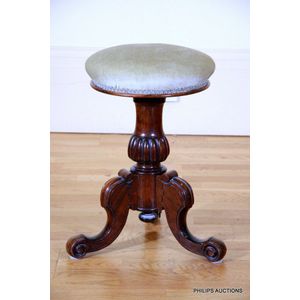Victorian Revolving Piano Stool with Carved Base and Leather Top
You must be a subscriber, and be logged in to view price and dealer details.
Subscribe Now to view actual auction price for this item
When you subscribe, you have the option of setting the currency in which to display prices to $Au, $US, $NZ or Stg.
- Paw Feet - A paw foot is a base of a furniture leg that resembles the paw of an animal, such as a lion or bear. It is a decorative feature that is often seen in traditional furniture designs, particularly in styles such as Chippendale, Queen Anne, and Georgian. A paw foot typically consists of a carved or moulded ball or disk at the bottom of the leg, which is then carved or shaped to resemble the toes or claws of an animal. The foot may be smooth or textured, depending on the design, and may be finished in a variety of materials, such as wood, metal, or even marble.
Paw feet are often used on heavier pieces of furniture, such as chests, tables, and chairs, to provide additional stability and support. They are also used as a decorative element, adding a touch of elegance and sophistication to the overall design.
"Hairy paw feet" is a term used to describe a variation of the foot design that features a carved or sculpted animal paw, such as a lion or bear, with hair or fur details. The hair or fur details were often carved in a realistic manner and added to the overall decorative effect of the furniture. Hairy paw feet were commonly found on furniture items such as tables, chairs, and cabinets and were popular in the 18th century. - Victorian Period - The Victorian period of furniture and decorative arts design covers the reign of Queen Victoria from 1837 to 1901. There was not one dominant style of furniture in the Victorian period. Designers used and modified many historical styles such as Gothic, Tudor, Elizabethan, English Rococo, Neoclassical and others, although use of some styles, such as English Rococo and Gothic tended to dominate the furniture manufacture of the period.
The Victorian period was preceded by the Regency and William IV periods, and followed by the Edwardian period, named for Edward VII (1841 ? 1910) who was King of the United Kingdom and the British Dominions and Emperor of India for the brief period from 1901 until his death in 1910.
This item has been included into following indexes:
Visually similar items

A Victorian Renaissance revival piano stool, 19th century, the stool with a floral tapestry stuffover seat of later fabrication, raised on an imposing base with a large fluted and knopped stem and three bold and generously scrolled buttress supports termin

A Victorian mahogany adjustable piano stool, second half 19th century, the stuffover stool having a knopped stem upon a tripod base with curvaceous acanthus embellished legs tipped with whorl feet, upholstered in pink velvet with decorative gimp. Height 52

A Victorian mahogany tripod based piano stool, 19th century, with maker's mark, Charles Wadman, Bath, no. 6693, with a shaped and reeded pedestal to sweeping legs with whorl feet, the stuffover seat upholstered in sage velvet, height 52 cm

A Victorian mahogany loo table, 19th century. 74 cm high, 140 cm wide, 101 cm deep
